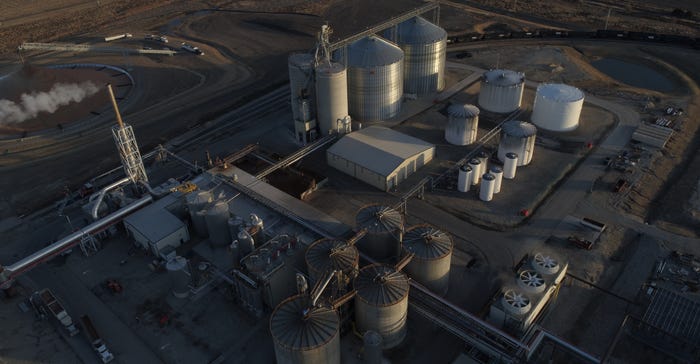
Each year, Kansas farmers grow nearly one-fifth of all the wheat grown in the United States — about an average of 328 million bushels, give or take a bushel.
So Kansas farmers know that it’s highly likely their wheat is found in the bread, cereal and pasta aisles of their local grocery store. But many might not know their wheat could also be found in today’s pet food aisle, the vegan food aisle, the alternative protein case, and even in some fuel tanks.
PureField Ingredients of Russell, Kan., is the nation’s leading producer of wheat protein, or vital wheat gluten, which is used as an ingredient in a variety of products for human and animal consumption. The plant produces 48 million pounds of wheat protein annually under its Heartland brand name, and that quantity is expanding to 70 million pounds in January.
Revenue streams
John Keaveney, vice president of food ingredients for PureField Ingredients, says some growers might know the plant under its former name, White Energy. The site at Russell consists of two integrated plants that produce wheat protein and ethanol.
Farmers may be more familiar with the ethanol side of the facility. The ethanol plant uses the wheat starch captured during the gluten process, as well as corn and sorghum, to produce more than 50 million gallons of ethanol a year. According to the company, its ethanol offers some of the lowest unit costs in the industry, with a low carbon footprint attractive to markets looking to capitalize with carbon credits.
Some of that ethanol will wind up in fuel tanks in California. Some of it is marketed as non-GMO, beverage-grade alcohol that will eventually wind up in vodka bottles. And during the COVID-19 crisis, 5 million gallons of that ethanol was turned into hand sanitizer for hospitals.
The ethanol market is a great market — but right now, the wheat protein market is even hotter, Keaveney says.
“There’s a massive shortage of wheat protein right now,” he explains. Global suppliers in Australia and Europe are finding it difficult to produce and transport wheat protein to their customers because of COVID-19 logistical complications.
“Wheat protein I would normally sell for, let’s say, 85 cents, is selling for five times that in small quantities,” Keaveney says. That’s how much the market for high-quality wheat protein has shot up.
But, what’s so special about wheat protein?
Versatility
There’s a nearly 700 million-pound market in the U.S. each year for wheat protein, which is split between baking and pet food applications, as well as in the alternative meat space, Keaveney says.
Wheat protein offers a big nutritional bang for vegetarians. For every 100 grams of wheat protein, there are 75.2 grams of protein, 13.8 grams of carbohydrates and 0 grams of sugar — all with just 370 calories. Low in carbs, extremely low in fat and soy-free, wheat protein also provides vital minerals like selenium and iron. And it is considered keto-friendly, for those who are vegetarian or vegan and observing a keto diet.
Bakers use wheat protein, or vital wheat gluten, to improve the crumbs and texture of breads. Its binding qualities are ideal for the pet food market. And wheat protein also is used in some personal care products, Keaveney says.
Lately, wheat protein has found a new application in the alternative meat space, Keaveney says. Wheat protein is the key ingredient in seitan, which is a vegan meat substitute, much like tofu is a soy-based meat substitute. It’s particularly ideal for chicken nugget alternatives because it offers a “tearing quality” much like a piece of chicken would tear apart, he explains.
“If you texturize it and do some other things, it really mimics chicken really very well,” he says.
Expanding markets
PureField Ingredients announced it will expand its facility to add 50% more capacity in the coming year, Keaveney says. That’s not in reaction to the hot market right now, but rather looking forward to the growing market for wheat protein in a growing range of products in the future, he adds.
For example, on the human consumption side, the rise of alternative proteins and keto diets may offer an expanding market for high-quality, source-verified wheat protein. PureField is a Safe Quality Food Institute-certified facility. This third-party audit ensures that the Heartland brand wheat protein follows strict quality and safety protocols that today’s large consumer packaged goods companies demand, Keaveney says. That could be very attractive to consumers.
Additionally, with America’s growing pet population, there’s a growing demand for high-quality wheat protein for pet food. A 2019-20 American Pet Products Association survey reports that 67% of American households own a pet. That’s nearly 85 million homes. APPA also reports that in 2020, during the height of the pandemic, as Americans started adopting cats and dogs in large numbers, Americans spent a total of $103.6 billion on their pets, with $42 billion of that coming from pet food and treats. APPA estimates those expenditures will only rise in 2021.
Those are just a couple more reasons for Kansas wheat farmers to take pride in a few more products in their grocery store than they did before.
About the Author(s)
You May Also Like






